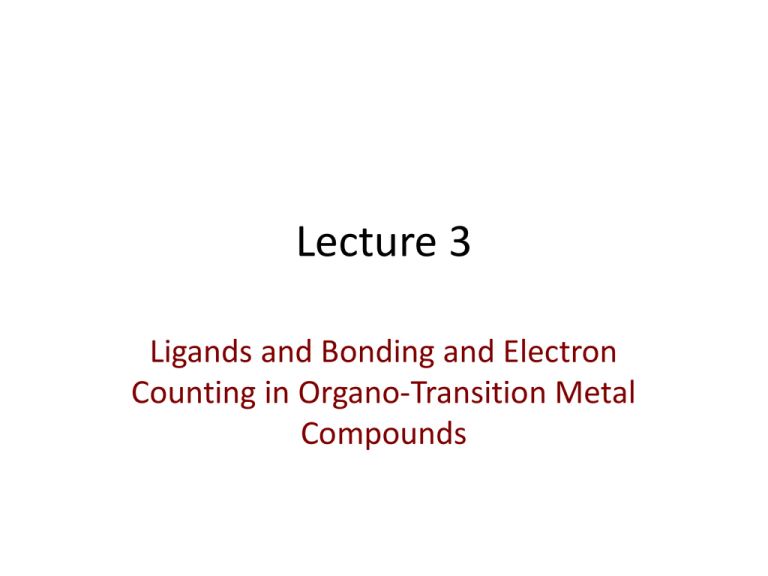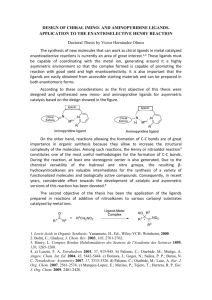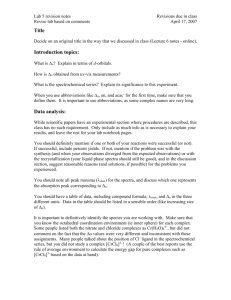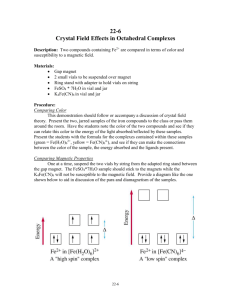Lecture 3 Ligands and Bonding and Electron Counting in Organo-Transition Metal Compounds
advertisement

Lecture 3 Ligands and Bonding and Electron Counting in Organo-Transition Metal Compounds Classification of Ligands: II The L, X, Z approach Malcolm Green : The CBC Method for Covalent Bond Classification used extensively in organometallic chemistry. L ligands are derived from charge-neutral precursors: NH3, amines, N-heterocycles such as pyridine, PR3, CO, alkenes etc. X ligands are derived from anionic precursors: halides, hydroxide, alkoxide alkyls—species that are one-electron neutral ligands, but two electron donors as anionic ligands. EDTA4- is classified as an L2X4 ligand, features four anions and two neutral donor sites. C5H5 is classified an L2X ligand. Z ligands are RARE. They accept two electrons from the metal center. They donate none. The “ligand” is a Lewis Acid that accepts electrons rather than the Lewis Bases of the X and L ligands that donate electrons. Illustration from page 57 Organometallic Chemistry Spessard Copyright © 2010 by Oxford University Press, Inc. Where are the electrons? Show me the electrons!! Electron counting and the 1 8- electron “Rule” (Guide is better. It is the “octet” rule for transition metals—but not so rigorously obeyed. ) Oxidative addition of H2 to chloro carbonyl bis triphenylphosphine Iridium(I) yields Chloro-dihydrido-carbonyl bis-triphenylphosphine Iridium(III). Note the neutral precursor, H2, becomes two X- ligands once added to Ir. H2 IrIII An ML3X complex An ML3X3 complex Electron count: 16 e Ir(I) d8 = 18 e Ir(III) d6 = 6 e 8e L ligands: 2 x (2) + 2 = X- ligand: 2 _ 6 3 L ligands: 3 x 2 = 6 3 X- ligands: 3 x 2 = 6 The η2-H2 Complexes - Typically d6, Oh structures of Cr0, Mo0, W0, FeII, RuII, IrIII. - Bonding: Delicate Balance Required for Stability M H H H H M M H H Morris, U. Toronto σ - donor Kubas, LANL σ* acceptor M2+(H-)2 - Examples of η2-H2 complexes H H CO R3P W0 PR3 OC C O Kubas ++ H H P P FeII C N H Morris P P Crabtree, Yale H H + Ph3P III H Ir N PPh3 C Crabtree Questions/classwork Electronic structure and properties TM 4p a2u, e1u e1u a1g e2g a2u 2Cp e2g, e2u e2u VCp2 CrCp2 MnCp2 FeCp2 CoCp2 NiCp2 4s a1g e1u 3d a1g, e1g, e2g a1g 18 Valence e-, Closed shell e2g e1g, e1u e1u e1g a 2u a1g http://www.ilpi.com/organomet/cp.html a1g, a2u Diamagnetic Thermally and air stable Reversible Fe2+/Fe3+ potential 8 MO Energy Level Diagram for ferrocene and related metallocenes http://www.ilpi.com/organomet/cp.html Types of ligands: σ- donor, π- donating and π- accepting σ d o n o r π- donor Π- accepting Organometallic Chemistry Spessard Copyright © 2010 by Oxford University Press, Inc. Illustration from page 64 Organometallic Chemistry Spessard Copyright © 2010 by Oxford University Press, Inc. To explain magnetism and colors, need electronic configuration of the Transition Metal Complex: MO diagram for σ-donor ligand sin octahedral complex prime example NH3 Simplified MO energy level diagram for Cr(CO)6. Note the empty π* orbitals. Only three are involved in overlap with metal d orbitals. Figure 3-1 Molecular orbitals of Cr(CO)6 (Only interactions between Ligand (σ- and π*) orbitals and metal d-orbitals are shown.) Organometallic Chemistry Spessard Copyright © 2010 by Oxford University Press, Inc. A more accurate MO energy level diagram for Cr(CO)6. prime example CO prime example F- Classification of Ligands: III Terminology and description of properties Strong Field/Weak Field Ligands Chelating Ligands and Denticity Polydentate: bi-, tri-, tetra, penta- Hexadentate, etc. 4-electron bridge; 3 center, 4 electrons 2-electron bridge; 3-center, 2 electrons Pincer Scorpionate Metallodithiolates Bridging Ligands Ambidentate Ligands Bulky Ligands Chiral Ligands Hemi-labile Ligands Non-innocent Ligands Spectator Ligands Designer Ligands So, how do we mix and match these ligands and metals with their various oxidation states to get stable molecules? 1. Hard/Soft Acid Base approach to stability 2. Knowledge of preferred coordination numbers and geometries The Chemical Bond: a) The sharing of an electron pair between two atoms. b) A mixture of electrostatic and covalent interactions. Together these interactions lead to stable molecules. Now, How about those colors and the magnetism in Werner type complexes? Where are the electrons? Show me the electrons!! Color: Electronic transitions due to energy levels whose gaps are in the visible range of the electromagnetic spectrum. Magnetism: partially filled orbitals, unpaired electrons. high spin: maximum no. of d electrons unpaired low spin: electrons paired up in d orbitals. WHY?? Bonding models: Valence bond (coordinate covalent bond needs empty orbitals on metal) Crystal Field Theory (originally from ionic crystals; influence of ligand lone pair repulsion on d-orbitals) Molecular Orbital Theory (all orbitals defined) Chem Wiki UC Davis Chem Wiki UC Davis Chem Wiki UC Davis Chem Wiki UC Davis Chem Wiki UC Davis Chem Wiki UC Davis Chem Wiki UC Davis Chem Wiki UC Davis Chem Wiki UC Davis Chem Wiki UC Davis Chem Wiki UC Davis Chem Wiki UC Davis Chem Wiki UC Davis Chem Wiki UC Davis



